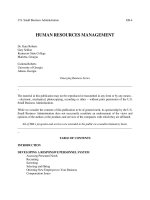human resources management _ section 5-performance management and appraisal
Bạn đang xem bản rút gọn của tài liệu. Xem và tải ngay bản đầy đủ của tài liệu tại đây (2.25 MB, 45 trang )
Human Resource
Management
ESSENTIAL PERSPECTIVES
© 2005 Southwestern College Publishing. All rights reserved.
PowerPoint Presentation
by Truong Thi Lan Anh
Performance Management
and Appraisal
Section 5
Robert L. Mathis John H. Jackson
© 2005 Southwestern College Publishing. All rights reserved. Lan Anh 11–2
Learning Objectives
After you have studied this section, you should be able to:
– Identify the components of performance management systems.
– Distinguish between performance management (PM) and
performance appraisal (PA), and between job criteria and
performance standards.
– Explain the administrative and developmental uses of performance
appraisal.
– Discuss the importance of training managers and employees about
performance appraisal, and give examples of several rater errors.
– Identify several concerns about appraisal feedback and ways to
make it more effective.
– Discuss why people stay or leave a company, and how to retain
them.
© 2005 Southwestern College Publishing. All rights reserved. Lan Anh 11–3
Nature of Performance Management
Performance
– What an employee does and does not do.
• Quantity of output • Quality of output
• Timeliness of output • Presence at work
• Cooperativeness
Performance Management
– Processes used to identify, encourage, measure, evaluate, improve,
and reward employee performance
• Provide information to employees about their performance.
• Clarify organizational performance expectations.
• Identify the development steps that are needed to enhance employee
performance.
• Document performance for personnel actions.
• Provide rewards for achieving performance objectives.
© 2005 Southwestern College Publishing. All rights reserved. Lan Anh 11–4
Performance
Management
Linkage
Figure 11–1
© 2005 Southwestern College Publishing. All rights reserved. Lan Anh 11–5
Components of
Effective Performance
Management
Figure 11–2
© 2005 Southwestern College Publishing. All rights reserved. Lan Anh 11–6
Potential Performance Criteria Problems
Objectivity
Deficiency Contamination
Performance
Criteria
© 2005 Southwestern College Publishing. All rights reserved. Lan Anh 11–7
Types of Performance Information
Figure 11–3
© 2005 Southwestern College Publishing. All rights reserved. Lan Anh 11–8
Identifying and measuring employee performance:
Performance standards vs. Job criteria
Job Criteria
– Important elements in a given job
© 2005 Southwestern College Publishing. All rights reserved. Lan Anh 11–9
Performance Standards
Performance Standards
– Expected levels of performance
• Benchmarks, goals, and targets
– Characteristics of well-defined standards
• Realistic
• Measurable
• Clearly understood
© 2005 Southwestern College Publishing. All rights reserved. Lan Anh 11–10
Terms Defining Standards on One Company
Figure 11–2
© 2005 Southwestern College Publishing. All rights reserved. Lan Anh 11–11
Uses of Performance Appraisal
Performance Appraisal (PA)
– The process of evaluating how well employees
perform their jobs when compared to a set of
standards, and then communicating the information
to employees.
– Informal Appraisal
• Day-to-day contacts, largely undocumented
– Systematic Appraisal
• Formal contact at regular time intervals, usually
documented
© 2005 Southwestern College Publishing. All rights reserved. Lan Anh 11–12
Difference Between Performance
Management and Performance Appraisals
Performance
Management
– Processes used to identify,
encourage, measure,
evaluate, improve, and
reward employee
performance.
Performance
Appraisal
– The process of evaluating how
well employees perform their
jobs and then communicating
that information to the
employees.
© 2005 Southwestern College Publishing. All rights reserved. Lan Anh 11–13
Difference Between Performance
Management and Performance Appraisals
© 2005 Southwestern College Publishing. All rights reserved. Lan Anh 11–14
Conflicting Uses for Performance Appraisal
Figure 11–4
© 2005 Southwestern College Publishing. All rights reserved. Lan Anh 11–15
Developmental Uses of
Performance Appraisal
Performance
Appraisal
Giving Performance
Feedback
Administering Wages
and Salaries
Identifying Strengths
and Weaknesses
© 2005 Southwestern College Publishing. All rights reserved. Lan Anh 11–16
Typical Division of HR Responsibilities
for Performance Appraisal
Figure 11–4
© 2005 Southwestern College Publishing. All rights reserved. Lan Anh 11–17
Discussion
1. What may happen if employee performance is
not appraised accurately?
2. Which HR activities can use the results of
performance appraisal as their information
inputs?
3. Which errors can happen when a superior
appraise his/her subordinates?
4. Which errors can happen when subordinates
appraise their boss?
© 2005 Southwestern College Publishing. All rights reserved. Lan Anh 11–18
Who Conducts Appraisals?
Supervisors who rate their subordinates
Employees who rate their supervisors
Team members who rate each other
Outside sources rating employees
Employees’ self-appraisal
Multisource (360° feedback) appraisal
© 2005 Southwestern College Publishing. All rights reserved. Lan Anh 11–19
Traditional
Performance
Appraisal:
Logic and Process
Figure 11–5
© 2005 Southwestern College Publishing. All rights reserved. Lan Anh 11–20
Employee Rating of Managers
Advantages
– Helps in identifying
competent managers
– Serves to make managers
more responsive to
employees
– Can contribute to the
career development of
managers
Disadvantages
– Negative reactions by
managers to employee
ratings
– Subordinates’ fear of
reprisals may inhibit them
from giving realistic
(negative) ratings
– Ratings are useful only for
self-improvement purposes
© 2005 Southwestern College Publishing. All rights reserved. Lan Anh 11–21
Team/Peer Ratings
Advantages
– Helps improve the
performance of lower-
rated individuals
– Peers have opportunity to
observe other peers.
– Peer appraisals focus on
individual contributions to
teamwork and team
performance.
Disadvantages
– Can negatively affect
working relationships.
– Can create difficulties for
managers in determining
individual performance.
– Organizational use of
individual performance
appraisals can hinder the
development of teamwork
© 2005 Southwestern College Publishing. All rights reserved. Lan Anh 11–22
© 2005 Southwestern College Publishing. All rights reserved. Lan Anh 11–23
Performance Appraisal Methods
Figure 11–7
© 2005 Southwestern College Publishing. All rights reserved. Lan Anh 11–24
Category Rating Methods
Graphic Rating Scale
– A scale that allows the rater to indicate an employee’s
performance on a continuum of job behaviors.
– Aspects of performance measured:
• Descriptive categories, job duties, and behavioral
dimensions
• Behavioral rating scales (e.g., BARS)
– Drawbacks
• Restrictions on the range of possible rater responses
• Differences in the interpretations of the meanings of scale
items and scale ranges by raters
• Poorly designed scales that encourage rater errors
• Rating form deficiencies limit effectiveness of the appraisal
© 2005 Southwestern College Publishing. All rights reserved. Lan Anh 11–25
Sample
Performance
Appraisal
Form
Figure 11–8









